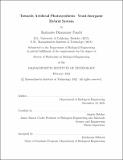| dc.contributor.advisor | Belcher, Angela | |
| dc.contributor.author | Pandit, Shalmalee Dhananjay | |
| dc.date.accessioned | 2023-10-18T17:07:07Z | |
| dc.date.available | 2023-10-18T17:07:07Z | |
| dc.date.issued | 2022-02 | |
| dc.date.submitted | 2023-09-22T15:24:47.494Z | |
| dc.identifier.uri | https://hdl.handle.net/1721.1/152451 | |
| dc.description.abstract | Artificially photosynthetic systems aim to store solar energy and chemically reduce carbon dioxide. These systems have been developed to use light to drive processes for carbon fixation into biomass and/or liquid fuels. We have developed a hybridbiological system that manages both genetically controlled generation of products along with the photoactivability of a semiconductor system. In this work, we show development of an inorganic-biological hybrid system that utilizes otherwise toxic cadmium waste to favor reduced product formation in yeast. In this work, we build on a system we recently developed to collect and remediate heavy metals from solution through genetic engineering of the yeast Saccharomyces cerevisiae. Yeast are genetically engineered to produce hydrogen sulfide that reacts with the cadmium ion to nucleate cadmium sulfide nanoparticles on the yeast cell wall. We show these nanoparticles can act as a light harvesting semiconductor complex that shares properties with the light-dependent reactions of photosynthesis. That is, upon light activation of the cadmium sulfide nanoparticles, favorable electron transfers fill resulting electron holes that alter the redox state of the yeast, creating metabolic conditions that promote reduced product formation. This could be a step towards developing an artificially photosynthetic organism, as the resultant conditions drives carboxylation of the five-carbon tricarboxylic acid (TCA) cycle metabolite alphaketoglutarate to form the six-carbon metabolite citrate. This incorporation of CO2 into yeast biomass allows for more carbon efficient ethanol production and illustrates how an engineered light-driven system can be used to increase the formation of a common biofuel. More generally, this study shows how nanoparticle semiconductor systems can be combined with metabolic engineering to enable formation of specific products. | |
| dc.publisher | Massachusetts Institute of Technology | |
| dc.rights | In Copyright - Educational Use Permitted | |
| dc.rights | Copyright MIT | |
| dc.rights.uri | http://rightsstatements.org/page/InC-EDU/1.0/ | |
| dc.title | Towards Artificial Photosynthesis: Yeast-Inorganic Hybrid System | |
| dc.type | Thesis | |
| dc.description.degree | Ph.D. | |
| dc.contributor.department | Massachusetts Institute of Technology. Department of Biological Engineering | |
| mit.thesis.degree | Doctoral | |
| thesis.degree.name | Doctor of Philosophy | |
